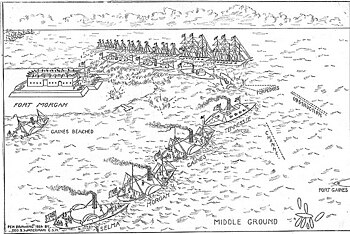.jpg/400px-Bataille_de_la_baie_de_Mobile_par_Louis_Prang_(1824-1909).jpg) |
| Battle of Mobile Bay |
In the summer of 1864 the ever advancing Union
arms had left the Confederacy in possession of only a handful of major
ports. One of these was Mobile, Alabama, and the Federals began to
develop plans to capture it also. Leading the effort was Rear Admiral
David Farragut, who had led the naval forces in the capture of New
Orleans and Vicksburg. His fleet was composed of 18 ships of various
types. Five were ironclad. They were up against three Confederate
forts. Forts Morgan and Gaines guarded each side of the entrance to
the bay, and the smaller Fort Powell was inside the harbor. The
Confederates also had the CSS Tennessee, an ironclad built by
the commander of the CSS Virginia, as well as three small
gunboats.
 |
| Sailing past the forts |
On August 3rd 1,500 Federal infantry
under General Gordon Granger were landed near Fort Gaines to attack
it from the land. Farragut delayed the attack two days so one of his
Monitors, the Tecumseh, could arrive. His fleet went out to
battle at dawn on August 5th, 150 years ago today. The
four ironclad monitors led the attack, followed by the rest of the
ships. The Tecumseh opened fire first at 6:47 AM., and the
battle soon opened on all sides.
.jpg/300px-USS_Tecumseh_(1863).jpg) |
| The Tecumseh sinks |
The USS
Tecumseh headed
straight for the Tennessee,
as Farragut had ordered. But her commander failed to avoid the
minefield that the Confederates had place in the water. It was not
long before she ran into a torpedo. It blew a harge hole in her side,
sending her to the bottom within minutes with most of her crew still
aboard. Seeing the fate of
the first Federal ship, the Brooklyn
slowed and signaled
Farragut for orders. According to legend the admiral replied, “D---
the torpedoes! Full speed ahead!” Farragut believed that the
Confederate torpedoes had been in the water too long to be of much
use, and it had been an unlucky hit that sunk the Tecumseh.
He decided to risk taking the rest of his ships through the
minefield.
 |
| The Tennessee |
Although
the CSS Tennessee was
greatly outnumbered by the Union fleet, she moved slowly forward to
try to ram the enemy vessels. The Federal boats easily avoided her
with their greater speed, and they themselves tried to ram. However,
their rams and cannon balls just bounced off the rebel boat's
iron sides. Although the Union fire could not pierce her hull, many of
her accessories were shot away. With his steamstack perforated, her
rudder chains cut and many of her gun shutters jammed, the Tennessee
was left nearly
helpless in the water. Soon
the Union monitors arrived, and they fired ball after ball into the
Confederate vessel. Finally with her sides bending under the heavy
pressure and with some of the crew down from splinter injuries, the
captain of the Tennessee
hauled down his flag.
Having run into the bay and dealt with the
Confederate naval threat, Farragut could now turn his attention to
the siege of the forts. A short Federal bombardment left them still
mostly intact at the end of the day.
 |
| A World War I recruitment poster showing Farragut at Mobile Bay |


0 comments:
Post a Comment